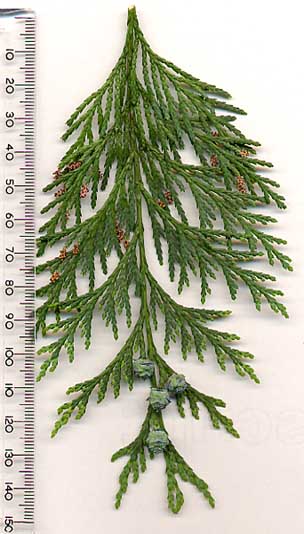Home
›
Cupressaceae
›
Chamaecyparis
›
Chamaecyparis lawsoniana (Lawson cypress, Port Orford cedar)
lawsoniana – named for Charles Lawson (1794-1873), a Scottish nurseryman who specialized in grass seeds and conifers
- he grew trees from seed sent to him in 1854 by William Murray while working on his “Notes on California Trees”
Native range: Western N. America

Leaves:
- scale-like
- closely appressed
- white “Y” or “X” mark on underside
- laterals much larger than facials
Cones:
- “soccer ball”
- small cone – 1/3” across, mature in a single season
- scales decussate
- male cones red, .25” in spring
Other characteristics:
- grayish bark
Relevant info:
- varies in growth form from shrub to tree w/ pyramidal growth to 200 ft.
- in cultivation, reaches half height of the native
- can live 600 years
- leaf scent not as sweet as Thuja, but sweeter than close relative Alaska yellow cedar (Callitropsis nootkatensis, formerly Chamaecyparis nootkatensis)
- wood is commercially valuable, in part because of its ability to resist rot
- species has suffered negative impact from timber industry
- susceptible to non-native root rot fungus (Phytophthora lateralis) in U.S., which threatens survival of remaining stands
- known in England & Europe as Lawson’s Falsecypress, and has been popular in their gardens since first introduction
- Port Orford, OR was location of first ID by western botanists
- ~300 types or cultivars selected from this species, more than any other conifer
Ecology & Adaptations:
- small native range
- seaward slopes in a coastal belt along Pacific Coast mountain ranges from Coos Bay in southwestern Oregon to the Klamath River in northwestern California, with isolated populations in northern California at higher elevations (<1700 m.)
- northern distribution is limited by frost
- cool Mediterranean climate (warm, dry summers and cool, wet winters) with summer fog, from which it is able to capture moisture on branchlets
- inland, found on moist sites (seeps, stream channels, bogs) or locations with lots of precipitation
- sandy and clay loams and rocky ridges
- adapted to ultramafic soils with high metal content
- compounds in sapwood (phloem) bind with metal ions, which prevents them from catalyzing damaging oxidation reactions within the tissues.
- very shade tolerant
- slow growth rates
- shaded individuals often take on a shrubby form, without a strong vertical leader (trunk)
- pollination by wind
- seed dispersal:
- usually within 1-3 tree heights
- small wings help the seed be carried by wind and float on water, which may be important in stream-side habitats
- produces abundant seed which enables seedling establishment under forest stands, which creates multi- aged stands
- vegetative reproduction:
- shallow root system makes species susceptible to windthrow, but layering (re-rooting from stems touching the ground) occurs in downed trees
- mature trees are fire resistant due in part to bark that can be as thick as 10 inches
- surviving trees provide seed source for new growth in burned areas
- compounds in plant tissues defend against microbial (bacterial and fungal) infections



